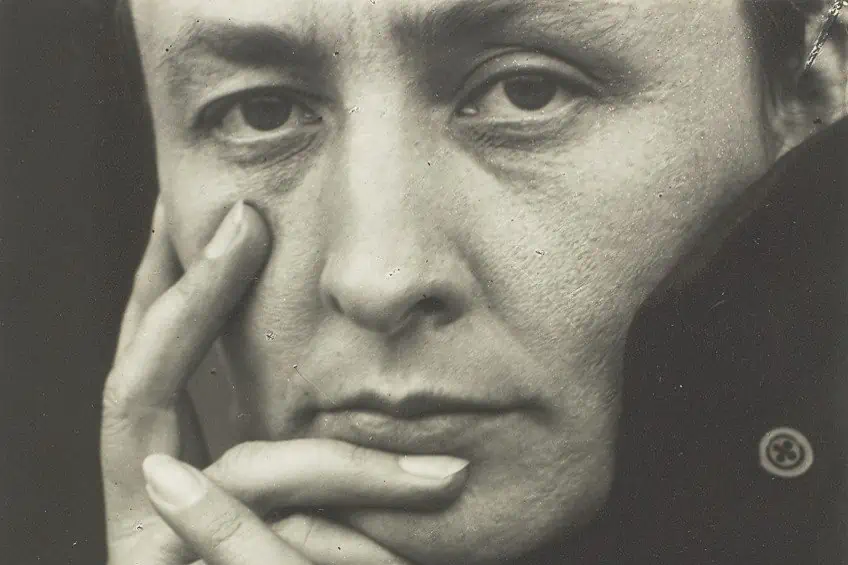Georgia O’Keeffe – A Pioneer in American Modernism
Georgia O’Keeffe, known for her iconic paintings, is widely recognized as one of the most influential American painters of the 20th century. Her unique artistic style and innovative approach to Georgia O’Keeffe art have captivated audiences for decades. In this article, we will explore the life and legacy of Georgia O’Keeffe, delving into her artwork, including her famous Georgia O’Keeffe portrait, and her contributions to the art world. We will also uncover the timeline of her life, including when did Georgia O’Keeffe die, and reflect on the lasting impact of her artistic legacy.
Contents
- 1 Georgia O’Keeffe’s Biography
- 1.1 Early Life and General Early Career Milestones: The Making of the O’Keeffe Painter
- 1.2 Career: An In-Depth Look into What Made Georgia O’Keeffe
- 1.2.1 1908: First Recognition
- 1.2.2 1908 – 1911: Commercial Artist in Chicago
- 1.2.3 1912 – 1914: Things Took a Turn
- 1.2.4 1916: Pivotal Artistic Development
- 1.2.5 A Brief Interlude to Introduce O’Keeffe and Stieglitz’s Relationship
- 1.2.6 1918: New York and Rising Fame
- 1.2.7 The 1920s: A New Artistic Identity
- 1.2.8 The 1930s to 1960s: New Mexico and Other Travels
- 1.2.9 The 1970s and 1980s: Managing Herself
- 2 The Legacy: What Georgia O’Keeffe Left Behind
- 3 Famous Georgia O’Keeffe Paintings
- 4 Book Recommendations
- 5 Frequently Asked Questions
Georgia O’Keeffe’s Biography
| Date of Birth | 15 November 1887 |
| Date of Death | 6 March 1986 |
| Country of Birth | America |
| Art Movements | Modernism, Abstract art, and Abstract Expressionism |
| Genre/Style | Modern art |
| Mediums Used | Pastel, charcoal, watercolor, and oil |
| Dominant Themes | Flowers, the wild and architectural landscapes of New Mexico, bones, and cityscapes of New York City |
Georgia O’Keeffe’s artwork, characterized by bold colors, organic forms, and a distinct sense of abstraction, has become synonymous with the American Southwest landscape. As a trailblazing O’Keeffe painter, she defied traditional artistic norms and created a body of work that continues to inspire and intrigue art enthusiasts around the world. Let us look at the life and career of this incredible artist.
Early Life and General Early Career Milestones: The Making of the O’Keeffe Painter
Georgia O’Keeffe, an artist known for her pioneering work in modern art, had a unique and fascinating early life that shaped her artistic journey. In 1887, on November 15, O’Keeffe was born into a family of seven children. The O’Keeffe’s lived in Sun Prairie, Wisconsin, and Georgia was the second child. From a young age, she showed an aptitude for art and started art classes early on in her life. Her childhood experiences in the rural Midwest, surrounded by nature and wide open spaces, would later influence her iconic Georgia O’Keeffe paintings. At the age of 18, O’Keeffe enrolled at the School of the Art Institute of Chicago, where she received formal creative education.
She studied a wide range of artistic techniques, including drawing, painting, and sculpture. However, she quickly became disillusioned with the traditional academic approach to art and began searching for her own artistic voice.

In 1907, O’Keeffe moved to New York City, where she briefly attended the Art Students League. During this time, she experimented with different styles and mediums, exploring abstraction and experimenting with innovative techniques. She was heavily influenced by the modern art movement of the time, including the work of Arthur Wesley Dow (1857 – 1922), a prominent artist and art educator, who emphasized the importance of composition and design in art. One of O’Keeffe’s earliest artworks from this period is her charcoal drawing titled No. 1 – Special (1915). This piece showcases her burgeoning talent for abstraction and her bold use of line and form. Her unique style began to emerge, characterized by simplified and abstract forms, often inspired by nature, which would become a characteristic of her Georgia O’Keeffe artwork.
O’Keeffe’s early work also reflected her interest in the concept of synesthesia, where she explored the connections between color, form, and music. Her innovative approach to art, along with her passion for experimentation, set her apart from her contemporaries and established her as a trailblazer in the art world.
In addition to her formal artistic training and exposure to the modern art movement, O’Keeffe’s early life experiences and surroundings played a significant role in shaping her artistic style. Growing up in the Midwest, she was deeply connected to nature, which would later inspire many of her Georgia O’Keeffe paintings. She was also captivated by the vastness and emptiness of the landscapes, which influenced her minimalist approach to composition.
Career: An In-Depth Look into What Made Georgia O’Keeffe
Georgia O’Keeffe’s professional career started at the School of the Art Institute of Chicago. In 1905, she began her training under the tutelage of renowned artists such as John Vanderpoel (1857 – 1911), O’Keeffe quickly distinguished herself and ranked at the top of her class. However, her education was interrupted when she contracted typhoid fever, forcing her to take a year off from her studies. Undeterred, O’Keeffe’s passion for art led her to New York City in 1907, where she enrolled in the Art Students League.
There, she studied under esteemed artists such as William Merritt Chase (1849 – 1916), Kenyon Cox (1856 – 1919), and F. Luis Mora (1874 – 1940).
1908: First Recognition
In 1908, O’Keeffe’s talent was recognized when she won the League’s William Merritt Chase prize. She received this award in the category of still-life painting for her oil study the Dead Rabbit with Copper Pot (1908). As a result, she was awarded a scholarship to attend the League’s outdoor summer school in Lake George, New York.
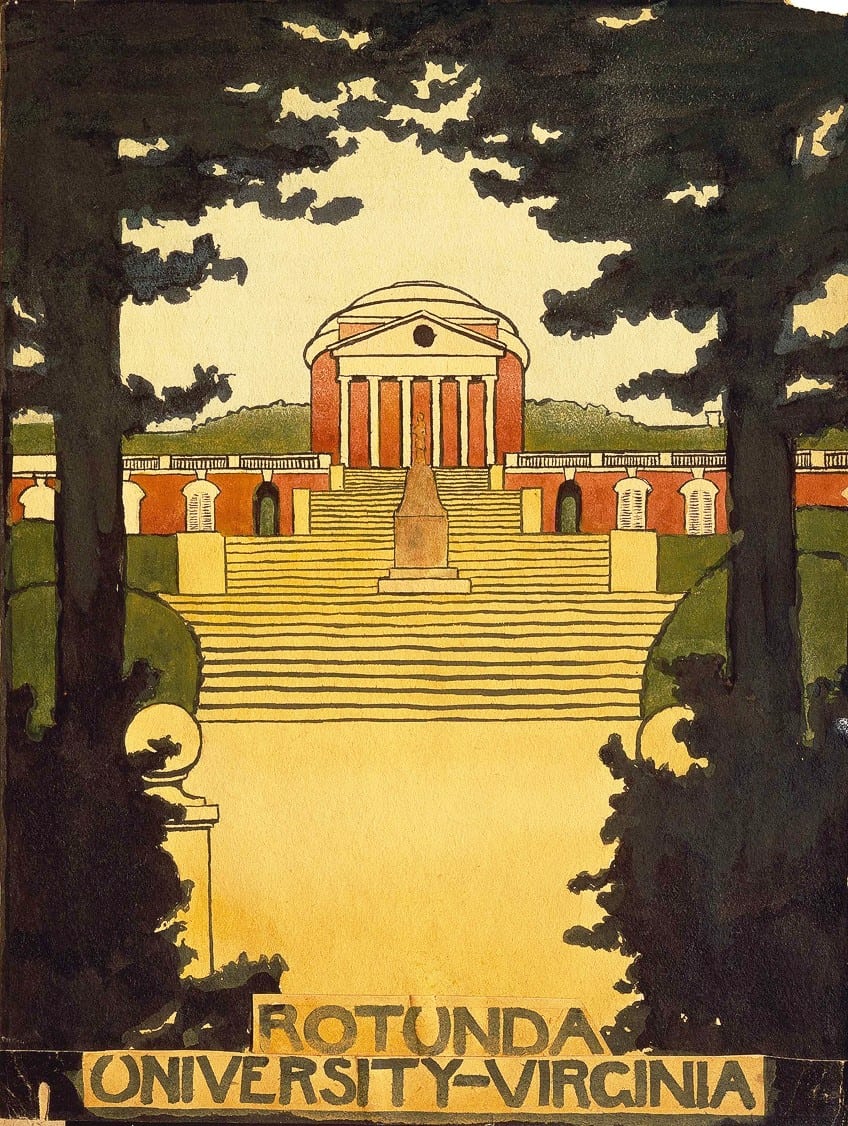
During her time in New York City, O’Keeffe frequented galleries, including 291, co-owned by her future husband, photographer Alfred Stieglitz (1864 – 1946). 291 was known for promoting the work of avant-garde artists and photographers from the United States and Europe, exposing O’Keeffe to cutting-edge artistic ideas and movements.
1908 – 1911: Commercial Artist in Chicago
Despite her early successes, O’Keeffe faced financial challenges that forced her to take a job as a commercial artist in Chicago in 1908. Her father had gone bankrupt, and her mother was seriously ill with tuberculosis. However, O’Keeffe’s artistic vision had already begun to shift away from the traditional mimetic tradition she had been trained in, and she was not interested in pursuing a career solely as a painter within those constraints. She took a break from painting and did not create any artwork for four years, during which time she worked and recuperated from illness.
She eventually moved with her family to Charlottesville, Virginia, and in 1911, she began teaching art, including at her former school, Chatham Episcopal Institute.
1912 – 1914: Things Took a Turn
In 1912, O’Keeffe’s artistic journey took a significant turn when she took a summer art class at the University of Virginia taught by Alon Bement (1876 – 1954), a faculty member from Columbia University Teachers College. Bement introduced her to the ingenious thoughts of Arthur Wesley Dow (1857 – 1922), which emphasized regulations of structure and formatting inspired by Japanese art. This exposure to new artistic concepts and approaches inspired O’Keeffe to experiment with abstract compositions and develop her own personal style that moved away from realism.

She continued to study and teach art in various locations, including Amarillo, Texas, where she taught in public schools and worked as Bement’s teaching assistant during the summers. She also attended courses at the University of Virginia and studied with Dow at Teachers College of Columbia University in the spring of 1914, additionally shaping her artistic philosophy.
1916: Pivotal Artistic Development
O’Keeffe’s time at the University of Virginia based on Dow’s principles proved to be pivotal in her artistic development and helped establish her as a leading figure in the American modernism movement. Her innovative charcoal abstractions based on her personal sensations caught the attention of Alfred Stieglitz, who exhibited ten of her drawings at his 291 Gallery in New York in 1916. Stieglitz praised O’Keeffe’s work as “purest, finest, sincerest things” and recognized her unique artistic vision.
This exhibition marked the beginning of a significant relationship between O’Keeffe and Stieglitz, who would later become her husband and a crucial supporter of her art.
A Brief Interlude to Introduce O’Keeffe and Stieglitz’s Relationship
Georgia O’Keeffe and Alfred Stieglitz are widely recognized as two of the most influential figures in American modern art. O’Keeffe was a painter and Stieglitz was a photographer, and the two had a romantic relationship that spanned several decades. Their relationship was fraught with controversy and scandal, but it also played a pivotal role in shaping the art world of the early 20th century. Alfred Stieglitz was already a prominent figure in the art world when he met Georgia O’Keeffe in 1916. He was a well-respected photographer and gallery owner, and he had already made a name for himself as a champion of modern art.
O’Keeffe was a young artist, relatively unknown at the time, who had sent Stieglitz some of her drawings on a whim. Stieglitz was immediately struck by her talent, and he invited her to exhibit her work at his gallery.
The two quickly developed a deep connection, and they started a romantic connection that endured for many years. Stieglitz was still married at the time, and their relationship caused a great deal of scandal in the art world. Stieglitz’s wife was understandably upset by the affair, and many of their friends and colleagues were shocked by the relationship. However, O’Keeffe and Stieglitz remained together, despite the criticism and the challenges they faced.
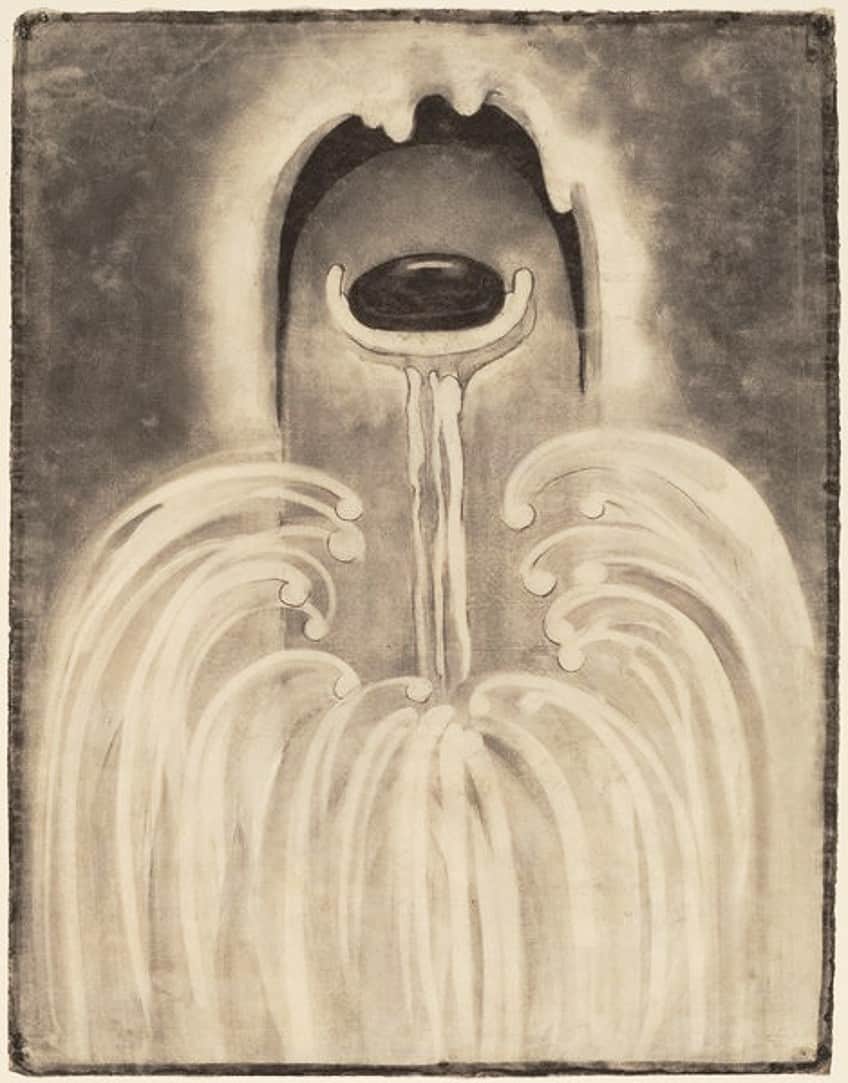
Stieglitz was a tireless promoter of O’Keeffe’s work, and he exhibited her paintings at his gallery on numerous occasions. He also photographed her extensively, producing a series of intimate and highly personal Georgia O’Keeffe portraits that have become some of the most iconic images in American art history. Stieglitz’s photographs of O’Keeffe are notable for their close-up focus on her body and her facial features, as well as for their dramatic use of light and shadow.
Despite their close relationship, O’Keeffe and Stieglitz were not always in sync artistically.
Stieglitz was known for his avant-garde approach to photography, while O’Keeffe’s work was more representational and grounded in the natural world. Nevertheless, their relationship had a profound impact on both of their careers, and their influence can still be felt in the art world today.
1918: New York and Rising Fame
In 1918, O’Keeffe took a break from teaching due to sickness and accepted Stieglitz’s proposal to sustain her painting for a year. She moved to New York and began living with Stieglitz, who was almost 24 years her senior and already married However, Stieglitz’s promotion of O’Keeffe’s work was not without controversy. He often associated her abstract art with her body, equating the creative process with sexual energies. He exhibited numerous photos of O’Keeffe, many of which portrayed her unclothed or partially dressed, often posing in front of her own conceptual sketches and paintings.
This association of O’Keeffe’s work with her gender and sexuality captured the imagination of critics, who interpreted her art through Freudian lenses.
Despite Stieglitz’s efforts to promote O’Keeffe’s work, she was a fellow of the National Woman’s Party, a revolutionary feminist association, and refused essentialist ideas that women possessed inherent temperament markers. She vigorously opposed the gendered understandings of her art and the sexualized public persona that Stieglitz had created for her. In response, she began to advertise herself as a deep, committed professional artist, reshaping her public appearance through published discussions and pictures taken by Stieglitz and other photographers.
The 1920s: A New Artistic Identity
O’Keeffe also made changes to her artistic style in an attempt to redefine herself. She curtailed her production of abstract art and limited their inclusion in exhibitions organized by Stieglitz after 1923. Instead, she focused on recognizable forms, such as flowers and natural or human-made objects, often rendered in precise detail and presented close-up as if seen through a magnifying lens. Critics often interpreted these works as evidence of her feminine nature as the basis of her art, but O’Keeffe’s paintings of flowers, for example, often depicted androgynous centers, challenging the notion of gendered interpretations.

Despite these challenges, O’Keeffe’s time in New York brought her professional success and artistic growth. Her paintings reflected the aesthetics of Modernism, with a focus on “less is more” and the influence of photography and Asian art. However, by the end of the 1920s, O’Keeffe felt pulled between her desire to pursue fresh artistic inspiration and her devotion to Stieglitz. She decided to spend the summer of 1929 in New Mexico, a landscape environment that reinvigorated her creative efforts and became a significant source of inspiration for her art.
The 1930s to 1960s: New Mexico and Other Travels
In the summers of 1930 and 1931, she spent time in New Mexico, but returned to Lake George in 1932, making brief trips to Canada and New York City for painting. In the autumn of 1932, O’Keeffe took a mural grant at Radio City Music Hall, but eventually deserted it due to specialized issues and Stieglitz’s objection. This blow, combined with Stieglitz’s fixation on a rich suitor Dorothy Norman, led to O’Keeffe undergoing an anxious meltdown in 1933. She healed in Bermuda and went back there the next spring.
In the autumn of 1934, O’Keeffe was in New Mexico and found Ghost Ranch, a breathtaking desert location north of Abiquiu. From that moment up to 1949, when she relocated to New Mexico, O’Keeffe practiced in New Mexico for a portion of the year, except for 1939 when she journeyed to Hawaii to paint at the request of the Dole Hawaiian Pineapple Company.
In 1940, she bought the house at Ghost Ranch that she used to visit from 1936, and in 1945 bought an old hacienda in Abiquiu with an enormous garden. Her friend Maria Chabot helped with the restoration of this new home from 1945 to 1949. During her time in New Mexico, O’Keeffe created notable paintings such as From the White Place (1940), Pelvis IV (1944), and Black Place III (1944), among others, depicting the unique natural and built structures of the region. These artworks allowed her to continue exploring her abstract language that she had developed in the 1910s, as the abstract shapes were naturally embedded in the subjects she observed. Her infatuation with the abstract qualities of the bare ridges of the Black Place led to a string of artworks that exemplify a new solution with abstraction, where the paintings show what O’Keeffe truly saw but are generated as abstractions.
Furthermore, O’Keeffe’s time in the Southwest enabled her to define herself to the masses in a new way. By allowing reporters and documentary photographers into her remote and strange life, she continuously represented herself as an unyielding, persistent, self-made nonconformist, departing from the world image that Stieglitz had created for her in the mid-1920s. In 1959, O’Keeffe began touring the globe, and she was deeply inspired by the landscapes and cityscapes visible from the plane windows. This just deepened her devotion to abstraction, resulting in a succession of artworks depicting atmosphere, ground, and water arrangements as seen from elevated above the earth, such as Blue, Black and Grey (1960). Despite being perceived as abstractions, these works still depicted what O’Keeffe actually saw.
The 1970s and 1980s: Managing Herself
Despite relying on other sellers to market her art after Stieglitz’s passing, O’Keeffe achieved career success by earning from the sales of her work and asserting ownership of about half of her entire body of work at the time of her passing. She actively participated in the demand for her own work by buying back many of her own works, stimulating the market, and preserving elevated costs.
O’Keeffe’s collection of her own works included some of her finest artistic accomplishments, such as five of her six Jack-in-the-Pulpit (1930) paintings.
She purposefully kept many of her early abstractions out of the market after 1923 in order to control how her work was analyzed. However, later in her life, she showed these early drawings next to her later abstract paintings, and they were well received and bought. Added to that, art influencers no longer saw them in a very deductive way but could appreciate them for their emotional quality and technical strength.
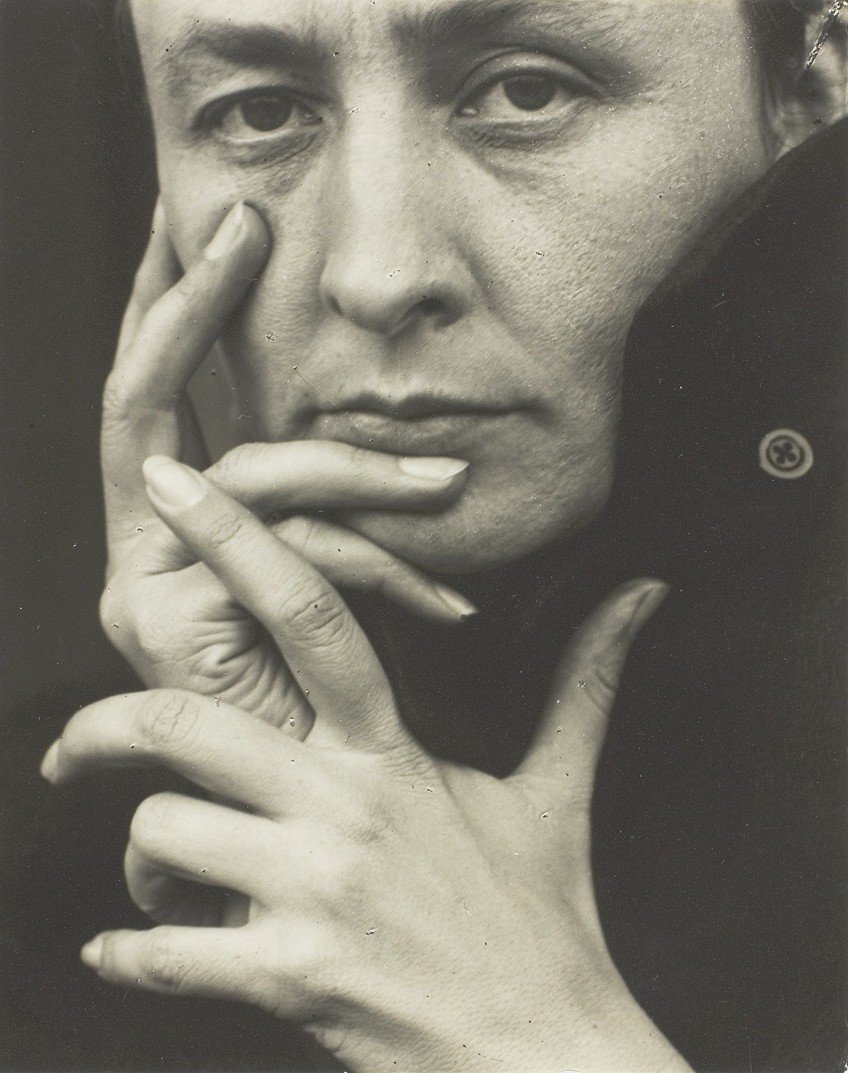
In the mid-1970s, O’Keeffe’s started struggling with her eyes and could only paint with assistance. Her friend and fellow artist, Juan Hamilton (1945-Present), helped her complete a book about her life and career autobiography, Georgia O’Keeffe (1976). They also partook in the creation of a movie about O’Keeffe’s life and art practice, Georgia O’Keeffe (1977). Hamilton is a sculptor and showed O’Keeffe how to work with clay. O’Keeffe created artworks in this medium as well as in watercolor, charcoal, pastel, and pencil. In 1984 when her health compelled her to relocate to Santa Fe, where she passed away in 1986.
The Legacy: What Georgia O’Keeffe Left Behind
Georgia O’Keeffe, known for her bold and vibrant paintings of flowers, landscapes, and abstractions, was a pioneering artist whose work has had a profound impact on art history. Her unique style and artistic vision challenged traditional notions of art and pushed boundaries, opening up new possibilities for artists that followed her. O’Keeffe’s influence can be seen in her pioneering approach to abstraction, her exploration of the feminine perspective, and her active role in managing and controlling her own career.
A Pioneering Approach to Abstraction
One of O’Keeffe’s most significant contributions to art history is her pioneering approach to abstraction. In the early 20th century, when abstraction was still a relatively new and controversial art form, O’Keeffe’s bold and innovative approach to abstraction set her apart as a trailblazer. Her abstract works from the 1910s and early 1920s, characterized by bold shapes, vivid colors, and dynamic compositions, were ahead of their time and challenged the conventional norms of representational art.
O’Keeffe’s abstraction was deeply connected to her own experiences and emotions, often reflecting her personal responses to nature and the landscape of New Mexico, where she lived and worked for many years.
Her abstract works were not simply depictions of the physical world, but rather expressions of her inner thoughts and emotions. By pushing the boundaries of abstraction, O’Keeffe expanded the possibilities of artistic expression and paved the way for future generations of abstract artists to explore new realms of creativity.
The Feminine Perspective
In addition to her pioneering approach to abstraction, O’Keeffe’s exploration of the feminine perspective in her art also had a significant impact on art history. As a female artist working in a male-dominated art world, O’Keeffe faced challenges and obstacles, but she was determined to create art on her own terms. Her paintings of flowers, often characterized by close-up views and enlarged details, have been interpreted as representations of the female body and have been celebrated as powerful expressions of feminine sensibility and sexuality.
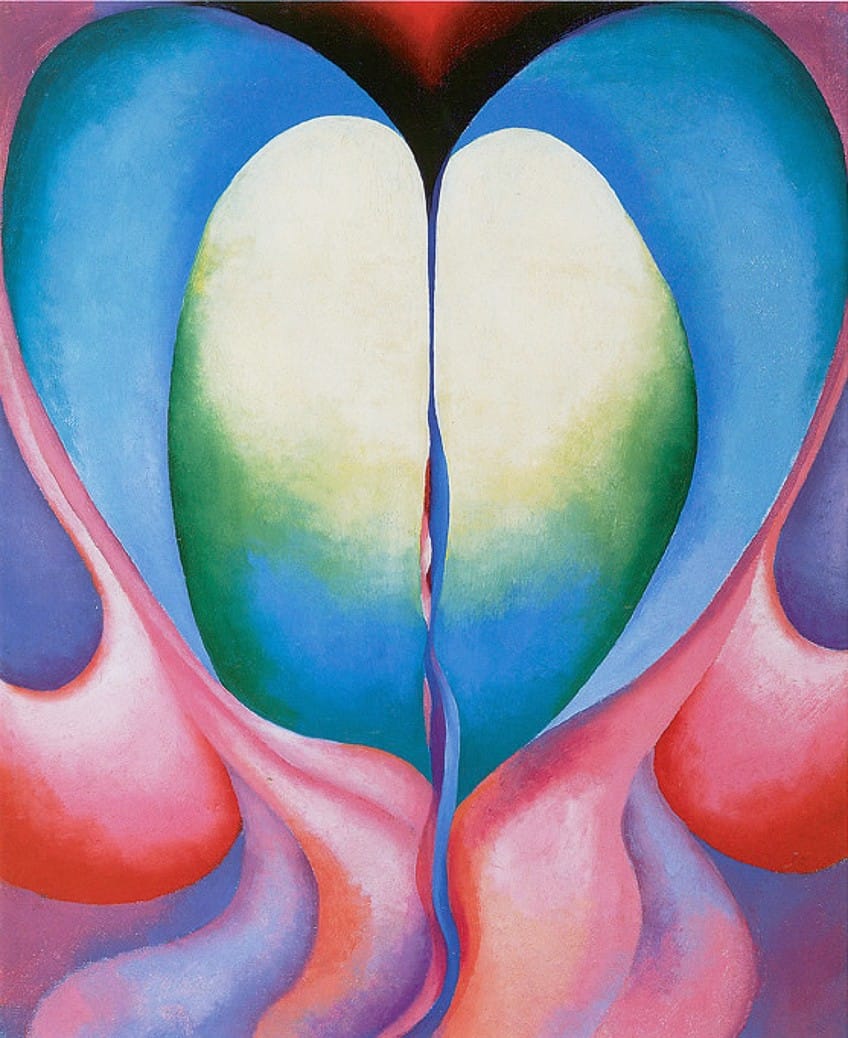
O’Keeffe’s depictions of the female body challenged traditional male-dominated perspectives on women in art, offering a fresh and unique viewpoint that celebrated the beauty and strength of the feminine. Her exploration of the feminine perspective in her art opened up new possibilities for female artists to assert their own voices and perspectives in the art world. O’Keeffe’s unapologetic celebration of the feminine in her art has had a lasting impact on art history, inspiring generations of artists to explore their own unique perspectives and challenge traditional gender roles in art.
Managing and Controlling Her Own Career
Furthermore, O’Keeffe’s active role in managing and controlling her own career was groundbreaking and set a precedent for artists to come. After the death of her husband and art dealer, Alfred Stieglitz, O’Keeffe took charge of her own career and became a shrewd businesswoman, relying on her own skills and knowledge to sell her work and maintain ownership of her artistic output. Her ability to successfully navigate the art market and maintain control over her artistic legacy was a significant achievement, especially for a female artist in a time when women’s roles in the art world were often limited.
O’Keeffe’s active participation in her own market, including buying back her own works and strategically managing her public image, demonstrated her agency and determination to shape her own artistic career.
O’Keeffe’s example has inspired and empowered artists to take control of their own careers, advocating for their own work and asserting their artistic autonomy, regardless of gender or background. Her bold and determined approach to managing her career has left a lasting legacy and serves as a source of inspiration for artists today.
Famous Georgia O’Keeffe Paintings
In this section of the article, we will explore three of O’Keeffe’s celebrated paintings: Jimson Weed, White Flower No. 1 (1932), Oriental Poppies (1928), and Ram’s Head White Hollyhock and Little Hills (1935). Through an in-depth analysis of these artworks, we will delve into O’Keeffe’s masterful technique, her use of color and composition, and the conceptual significance of these paintings. By examining these key works, we will gain a deeper understanding of O’Keeffe’s artistic legacy and her contributions to the field of art history.
Oriental Poppies (1928)
| Date | 1928 |
| Medium | Oil on canvas |
| Dimensions (cm) | 101.6 × 76.2 |
| Type of Painting | Natural painting |
| Art Movement | Modernism |
| Location | Weisman Art Museum, Minneapolis, United States |
Oriental Poppies, painted by Georgia O’Keeffe in 1928, is a striking and powerful artwork that showcases her distinct style and approach to depicting flowers. Visually, Oriental Poppies is characterized by bold, vibrant colors and large, sweeping brushstrokes. The poppies are rendered in shades of red, orange, and pink, with their petals appearing almost translucent as if illuminated from within. The composition is asymmetrical, with the poppies arranged off-center, dominating the canvas with their large size and dynamic forms.
Conceptually, Oriental Poppies reflects O’Keeffe’s fascination with the beauty and essence of flowers as natural forms. She often painted flowers in close-up, magnified views, isolating them from their surroundings to highlight their unique shapes, colors, and details.
In Oriental Poppies, O’Keeffe presents the flowers as abstracted forms, focusing on their bold, curvaceous petals and intricate centers, while omitting any reference to stems or leaves. This abstraction creates a sense of heightened intimacy and intensity, inviting the viewer to experience the flowers in a new and profound way. One of the notable features of Oriental Poppies is its sensuous and suggestive quality. O’Keeffe’s depiction of the poppies as bold, expressive forms with their alluring colors and undulating shapes have been interpreted as having sexual connotations.

The red, fleshy petals and the central dark markings evoke associations with female anatomy, and the overall composition exudes a sense of vitality and sensuality. Furthermore, Oriental Poppies exemplifies O’Keeffe’s exploration of the interplay between abstraction and representation. While the painting is undoubtedly abstract in its emphasis on form, color, and composition, it also retains recognizable elements of the poppy flowers. This tension between abstraction and representation is a hallmark of O’Keeffe’s style, blurring the lines between the real and the abstract, challenging traditional notions of representation in art.
Jimson Weed, White Flower No. 1 (1932)
| Date | 1932 |
| Medium | Oil on canvas |
| Dimensions (cm) | 180 × 212 |
| Type of Painting | Natural painting |
| Art Movement | Modernism |
| Location | Indianapolis Museum of Art, Indianapolis, United States |
Jimson Weed, White Flower No. 1, painted in 1932, is a stunning example of Georgia O’Keeffe’s iconic floral paintings. This large-scale oil painting features a close-up view of a single white Jimson weed flower, rendered with exquisite detail and precision. Visually, the painting is characterized by its bold composition and strong use of color. The white flower stands out against the dark background, creating a stark contrast that draws the viewer’s attention. The petals of the flower are rendered with meticulous brushwork, capturing their delicate, velvety texture and subtle variations in color.
O’Keeffe’s attention to detail is evident in the way she portrays the intricate folds and curves of the flower, as well as the subtle shadows and highlights that give it depth and dimension. The composition is balanced, with the flower placed off-center, creating a sense of dynamic tension and visual interest.
Conceptually, Jimson Weed, White Flower No. 1 reflects O’Keeffe’s unique approach to depicting the natural world. O’Keeffe often zoomed in on small details of flowers and other natural forms, isolating them from their surroundings and presenting them on a larger-than-life scale. By doing so, she invites viewers to see these objects in a new way, not just as simple representations of nature, but as complex and intriguing subjects in their own right. As stated above, O’Keeffe’s floral paintings are often associated with femininity and sensuality, and Jimson Weed, White Flower No. 1 is no exception.

The large, voluptuous flower takes on a sensual quality, inviting viewers to appreciate its beauty in a deeply intimate and personal way. Furthermore, O’Keeffe’s floral paintings are often interpreted as representations of her inner world and her exploration of self. The intense focus on a single flower, often devoid of any contextual clues, allows for a sense of abstraction and universality. The white color of the flower in Jimson Weed, White Flower No. 1 further enhances this sense of purity and transcendence, as the flower seems to float in a timeless and ethereal realm.
Ram’s Head White Hollyhock and Little Hills (1935)
| Date | 1935 |
| Medium | Oil on canvas |
| Dimensions (cm) | 91.4 x 76.2 |
| Type of Painting | Natural painting |
| Art Movement | Modernism |
| Location | Brooklyn Museum, New York City, United States |
Ram’s Head White Hollyhock and Little Hills, painted by Georgia O’Keeffe in 1935, is a captivating and enigmatic artwork that showcases her distinctive style and approach to depicting the natural world. Visually, Ram’s Head White Hollyhock and Little Hills is characterized by O’Keeffe’s signature use of bold, simplified forms and a limited color palette. The central element of the painting is the ram’s head, rendered in smooth, curvaceous lines that are reminiscent of O’Keeffe’s earlier depictions of animal skulls.
The ram’s head is painted in shades of creamy white, with subtle variations in tone and texture, giving it a tactile quality. The background is dominated by a series of brown softly undulating hills and a cloudy sky in shades of blue, green, and purple, which provide a serene and atmospheric backdrop to the ram’s head.
Conceptually, Ram’s Head White Hollyhock and Little Hills is a study in contrasts and symbolism. The ram’s head, with its imposing yet graceful form, is a powerful symbol of vitality and strength, while the hollyhock flowers, delicately painted in white, represent purity and innocence. The juxtaposition of the ram’s head and the hollyhock flowers creates an intriguing tension, suggesting a dynamic interplay between masculine and feminine energies, power and fragility, and the natural and the cultivated.
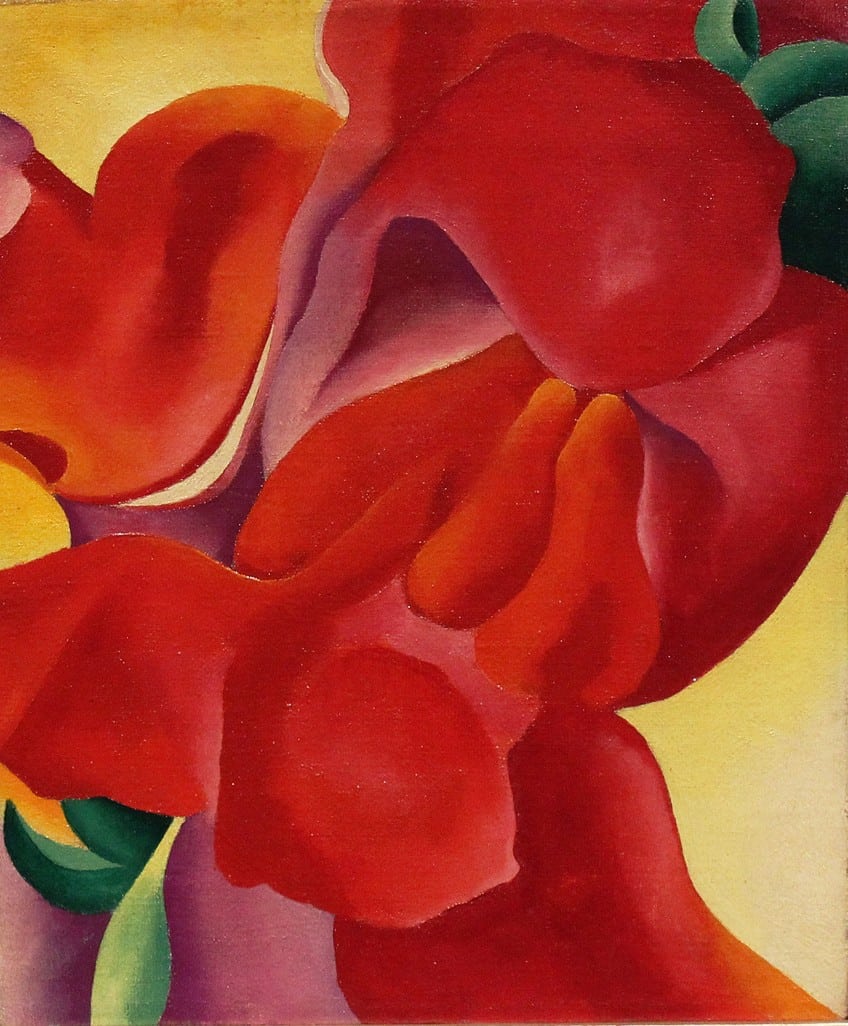
The composition of Ram’s Head White Hollyhock and Little Hills is carefully balanced, with the ram’s head and the hollyhock flowers positioned off-center, creating a sense of asymmetry and dynamism. The smooth, flowing lines of the ram’s head and the undulating hills create a sense of movement and rhythm, adding to the overall sense of vitality and energy in the painting. As with many of O’Keeffe’s works, Ram’s Head White Hollyhock and Little Hills can also be seen as an exploration of abstraction and representation. While the ram’s head and the hollyhock flowers are rendered with recognizable forms, they are also simplified and stylized, reducing them to their essential shapes and forms.
This abstraction allows O’Keeffe to convey the essence of the subject matter, going beyond mere representation to capture the emotional and symbolic significance of the objects.
Book Recommendations
Below is a list of excellent books on the life and art of O’Keeffe. These books provide either a detailed account of the story of her life, career, or both.
Georgia O’Keeffe: One Hundred Flowers (2018) by Georgia O’Keeffe
Georgia O’Keeffe: One Hundred Flowers is a captivating book that showcases the stunning floral paintings of the renowned American artist Georgia O’Keeffe. Published in 2018, this book is a visual celebration of O’Keeffe’s iconic flower paintings, which are known for their boldness, vibrancy, and unique perspective. Accompanying the visually stunning images are insightful essays that provide context, analysis, and interpretations of O’Keeffe’s flower paintings. These essays shed light on O’Keeffe’s artistic techniques, her inspirations, and her innovative approach to depicting flowers as powerful symbols of femininity, nature, and abstraction. They also explore the relationship between O’Keeffe’s flower paintings and her deep connection to the New Mexico landscape, where she spent much of her life and found endless inspiration.
- New 30th-anniversary edition
- Showcases extraordinary reproductions of O'Keeffe's flower paintings
- Insightful essays accompany the reproductions of O'Keeffe's artworks
Georgia O’Keeffe (2021) by D.A.P./Museo Nacional Thyssen-Bornemisza
If you’re looking for a comprehensive and visually stunning book on the iconic American artist Georgia O’Keeffe, Georgia O’Keeffe (2021) published by D.A.P./Museo Nacional Thyssen-Bornemisza is an excellent choice. This book serves as a catalog for the major retrospective exhibition of O’Keeffe’s work held at the Museo Nacional Thyssen-Bornemisza in Madrid in 2021, showcasing her remarkable career spanning over six decades. In addition to the visual analysis, the book also delves into O’Keeffe’s life, providing biographical information, anecdotes, and personal insights that shed light on her motivations, challenges, and achievements. It explores her pioneering role as a female artist in the male-dominated art world of her time, her relationships, and her enduring legacy as a trailblazing artist.
- Offers a complete look at Georgia O'Keeffe's career
- Ranges from works produced between 1910 and 1920
- Selection of images is accompanied by quotes from O’Keeffe on her art
Georgia O’Keeffe: To See Takes Time (2023) by Samantha Friedman
If you are a fan of Georgia O’Keeffe’s art or interested in learning more about this iconic American artist, Georgia O’Keeffe: To See Takes Time by Samantha Friedman is a must-read book. This beautifully illustrated volume offers a fresh and insightful perspective on O’Keeffe’s work, life, and artistic philosophy. Samantha Friedman, a curator at the Museum of Modern Art (MoMA), provides a comprehensive and engaging exploration of O’Keeffe’s artistic journey, spanning her early days as an art student to her later years as a pioneering figure in American modern art. The book delves into O’Keeffe’s unique artistic style, her use of color and form, and her innovative approach to depicting the natural world.
- A revelatory new volume on the artist's lesser-known works
- Richly illustrated book on O'Keefee's artworks
- Delves into O'Keefe's unique art style
In conclusion, Georgia O’Keeffe, the pioneering American artist, has left an indelible mark on the world of art with her groundbreaking work. Her innovative approach to depicting nature, her bold use of color and form, and her unique perspective on flowers as powerful symbols have established her as a visionary figure in art history. O’Keeffe’s ability to capture the essence of her subjects with meticulous detail and unparalleled creativity has earned her a place among the most influential artists of the 20th century. Her artistic legacy continues to inspire and captivate audiences, making her an enduring figure in the canon of modern art. As a painter, O’Keeffe pushed the boundaries of traditional artistic conventions, creating a visual language that continues to resonate with art enthusiasts and scholars alike. Her contributions to the art world are immeasurable, and her legacy as an artist will continue to thrive for generations to come.
Frequently Asked Questions
How Did Georgia O’Keeffe’s Childhood Influence the Development of Her Art?
Georgia O’Keeffe’s early life was marked by her artistic talent, formal training, and exposure to the modern art movement, as well as her personal experiences and surroundings. Her childhood in the Midwest, her studies in Chicago and New York City, and her passion for experimentation and innovation all contributed to the development of her unique artistic style. Through her earliest artworks, she began to establish herself as a groundbreaking artist, paving the way for her illustrious career as one of the most influential American artists of the 20th century.
When Did Georgia O’Keeffe Die?
Georgia O’Keeffe passed away on March 6, 1986, at the age of 98. She died in Santa Fe, New Mexico, where she had moved to in 1984 due to her failing health. O’Keeffe had a long and illustrious career as an artist, making significant contributions to the world of art and becoming an icon of American modernism. Her legacy continues to inspire and influence artists to this day, and her works remain highly regarded in the art world.
What Made Georgia O’Keeffe Such an Influential Artist?
Georgia O’Keeffe’s influence on art history is multifaceted and far-reaching. Her pioneering approach to abstraction, her exploration of the feminine perspective, and her active role in managing and controlling her own career have had a profound impact on the art world. O’Keeffe’s innovative and trailblazing spirit pushed the boundaries of art and opened up new possibilities for artists that followed her. Through her bold and vibrant paintings, O’Keeffe challenged traditional notions of art and offered a unique perspective that celebrated the beauty of nature and the strength of the feminine. Her abstract works and depiction of flowers as symbols of femininity were groundbreaking, and her active role in managing her career set a precedent for artists to assert their own agency and autonomy in the art world.
Nicolene Burger, a South African multimedia artist and creative consultant, specializes in oil painting and performance art. She earned her BA in Visual Arts from Stellenbosch University in 2017. Nicolene’s artistic journey includes exhibitions in South Korea, participation in the 2019 ICA Live Art Workshop, and solo exhibitions. She is currently pursuing a practice-based master’s degree in theater and performance. Nicolene focuses on fostering sustainable creative practices and offers coaching sessions for fellow artists, emphasizing the profound communicative power of art for healing and connection. Nicolene writes blog posts on art history for artfilemagazine with a focus on famous artists and contemporary art.
Learn more about Nicolene Burger and about us.
Cite this Article
Nicolene, Burger, “Georgia O’Keeffe – A Pioneer in American Modernism.” artfilemagazine – Your Online Art Source. October 5, 2023. URL: https://artfilemagazine.com/georgia-okeeffe/
Burger, N. (2023, 5 October). Georgia O’Keeffe – A Pioneer in American Modernism. artfilemagazine – Your Online Art Source. https://artfilemagazine.com/georgia-okeeffe/
Burger, Nicolene. “Georgia O’Keeffe – A Pioneer in American Modernism.” artfilemagazine – Your Online Art Source, October 5, 2023. https://artfilemagazine.com/georgia-okeeffe/.


